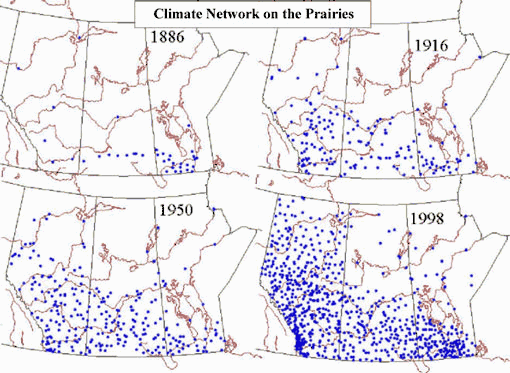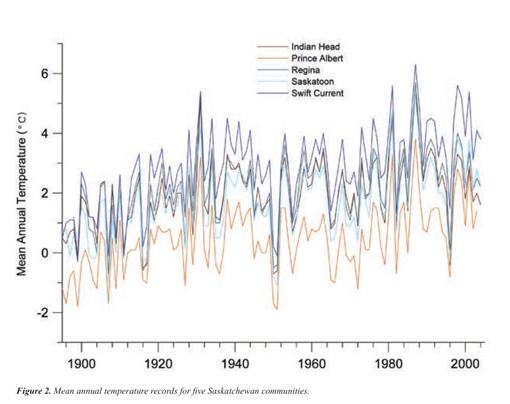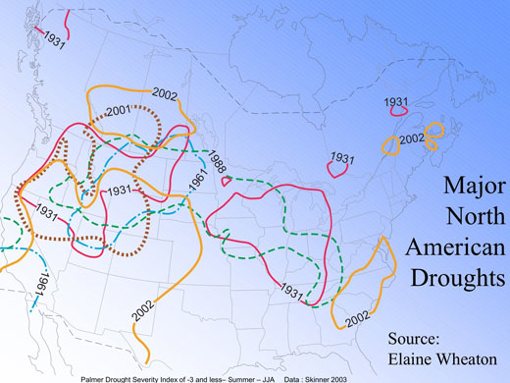Saskatchewan's Climate: Past
Most weather records in the Prairie Provinces are less than 110 years in length (Figure 1). However, evidence of past climates can be found in lake sediments, tree rings and sand dune deposits since they preserve the response of ecosystems to climate fluctuations. There are three major conclusions arising from the assessment of past climates:
1. Warmer
Figure 2 shows the rise in mean annual temperature since 1895 for five locations across Saskatchewan.
Upon closer inspection, recent temperature trends strongly suggest that Saskatchewan is not getting much hotter, but rather “less cold”: there has been a larger increase in daily minimum temperatures (as opposed to maximum) and the largest warming has occurred during winter and early spring, resulting in a longer frost-free period and more growing degree days.
2. Drier
With a warmer, longer summer the deficit between precipitation and potential water loss by evapotranspiration has been growing (1 to 4 mm/yr in southern Saskatchewan). Saskatchewan is getting drier.
Drought is a common feature to the Prairies. The climate of the twentieth century was relatively favourable for European settlement of the Prairies as it lacked the sustained droughts of proceeding centuries.
The date and extent of drought in North America over the past century is illustrated in Figure 3. Severe and prolonged drought was experienced in the early part of the 20th century (1915 through the 1930's). The recent droughts of 2001- 2002 were less prolonged and severe. However, 2001-2002 was the worst two-year drought since 1929-1930, while 2002 was one of the worst one-year droughts on record.
3. Variable
Reconstructions of the climate of the past several millennia reveal shifts in moisture regimes over centuries and also droughts that are more severe and prolonged in the centuries before Saskatchewan was settled by EuroCanadians. This longer view of the climate suggests that the climate conditions that we have experienced in Saskatchewan over the past century, while variable, did not include the range of climate conditions of the last 1,000 years. Therefore deeper and longer droughts than we have experienced in the past century are definitely possible.
Next Page › Saskatchewan's FUTURE Climate
Sources:
- Henderson, N. and Sauchyn, D. editors (2008): Climate Change Impacts on Canada's Prairie Provinces: A Summary of our State of Knowledge. PARC Summary Document No. 08-01, 19 p.
- Hopkins, R. (no date): Climate Network of the Prairies (Map Series), Environment Canada. From Sauchyn, D. (2002): Climate Change, Water and Agriculture: Searching for the Big Picture (Presentation to Alberta Institute of Agrologists Calgary Branch February 25, 2002), PARC.
- Sauchyn, D. et al (2009): Saskatchewan's Natural Capital in a Changing Climate: An Assessment of Impacts and Adaptation. 162 pp. PARC.
- Wheaton, E., (2004?): Major North American Droughts (Map), Saskatchewan Research Council. From Sauchyn, D. (2004): A 330-year Climate and Human History of Prairie Drought (Presentation to Canadian Prairies Drought Workshop - Science, Monitoring and Prediction, Calgary, May 27-28, 2004), PARC.


